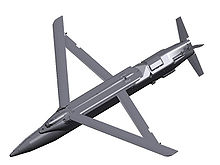Since the days of the first Gulf War, when it became clear to the world that precision air strikes would be the “go to” option for the opening rounds of nearly any theater scale military operations, the technology of precision guided munitions has increased rapidly. We have witnessed bombs being guided into their targets by lasers, GPS, and even a human watching through a camera on the nose of the weapon. Once the concept of precision guidance was no longer a novelty, the virtuous auspices of limiting collateral damage and economic efficiency have led military planners and weapons designers to push the envelope of precision weapon technology even further.
During the Desert Storm era, the smallest precision bombs available packed 500 lb high-explosive warheads, and the 500 pounder was typically used on only the smallest of targets. They certainly were precise enough on surgical targeting, but the massive explosion and pressure wave still causes widespread devastation to buildings and well, people, that are in the vicinity of the blast. Now I’m not saying that it’s ever goign to be possible to truly eliminate collateral damage, but I believe technology has reached a stopping point concerning precision-guided air-launched munitions. It’s not as if limiting collateral damage is such a bad thing after all; so I guess we can go ahead and bestow the honorable hallmark characteristic of the next wave of precision munitions: Efficiency…because accuracy is a given.
Fresh on the block is the new GBU-39 Small Diameter Bomb. The GBU-39 is the first 250 lb class precision guided munition, and is not only intended to allow the pilot to strike more targets per sortie, but also to -you guessed it- limit collateral damage. A full rack of GBU-39s, 4 bombs total, can easily take the place of one 2000 lb GBU 109 “bunker buster” guided bomb on typical strike platforms such as the F-15C or F-22 Raptor aircraft. While the 2000 lb GBU-109 penetrator definitely retains its place as a select weapon of choice for large and hardended targets, the GBU-39 SDB surpasses the GBU-109 in many different realms of performance. For starters, the GBU-39 also has significant stand-off capabilities. With it’s guidance wings, the bomb can coast into targets from far greater ranges than the GBU-109, from more than 40 nautical miles out. Likewise, the design of the warhead also allows the Small Diameter Bomb to achieve the same penetration capabilities of it’s much larger 2000 lb counterpart. All in all, the SMB GBU-39 allows for a great amount of flexibility for whomever is designing strike missions for an urban environment.
Not only does the GBU-39 Small Diameter Bomb limit it’s size to only 250 lbs, it also can be fitted with different types of warheads, one of which is specially designed to limit the blast radius and shockwave of the explosion. This new explosive is called D.I.M.E., short for Dense Inert Metal Explosive. DIME explosives basically combine a powder of inert metals–inert means that the metal is resistant to chemical reactions–into the explosive, which essentially weighs down the blast. The explosive ignites, but the metal powder will only fly so far before air resistance and gravity will slow it down. DIME explosives are proven to limit the blast radius of explosions, but they are also notorious for the effects that they can have on personnel. Decapitations, dismemberments, and even cancer later down the line caused by the imbedded metal powder are all facts of life when DIME is deployed. i guess the counter-point is that those folks were at the wrong place at the wrong time, especially under the known threat of air raids.Fast forward to Israel’s Operation Cast Lead against the Hamas regime in Gaza, and you’ve got the exact scenario where this weapon is intended to be used. A crowded urban environment, where military targets are amorphous among the civilian landscape, and limiting collateral damage is essential to maintaining some semblance of self-restraint, saw small diameter bombs being deployed in large numbers. Indeed, reports have come out of Gaza of people suffering the effects of DIME explosives, but the IDF remains deflective about admitting to their use. The use of the GBU-39 that isn’t debated is the penetrator version being deployed against the smuggling tunnels at the Rafah crossing. The IDF deployed multiple GBU-39 penetetrators along the lengths of the tunnels, essentially burying them in successive sections.


 01.09
01.09
 ManWithNoBrain
ManWithNoBrain






0 komentar:
Posting Komentar